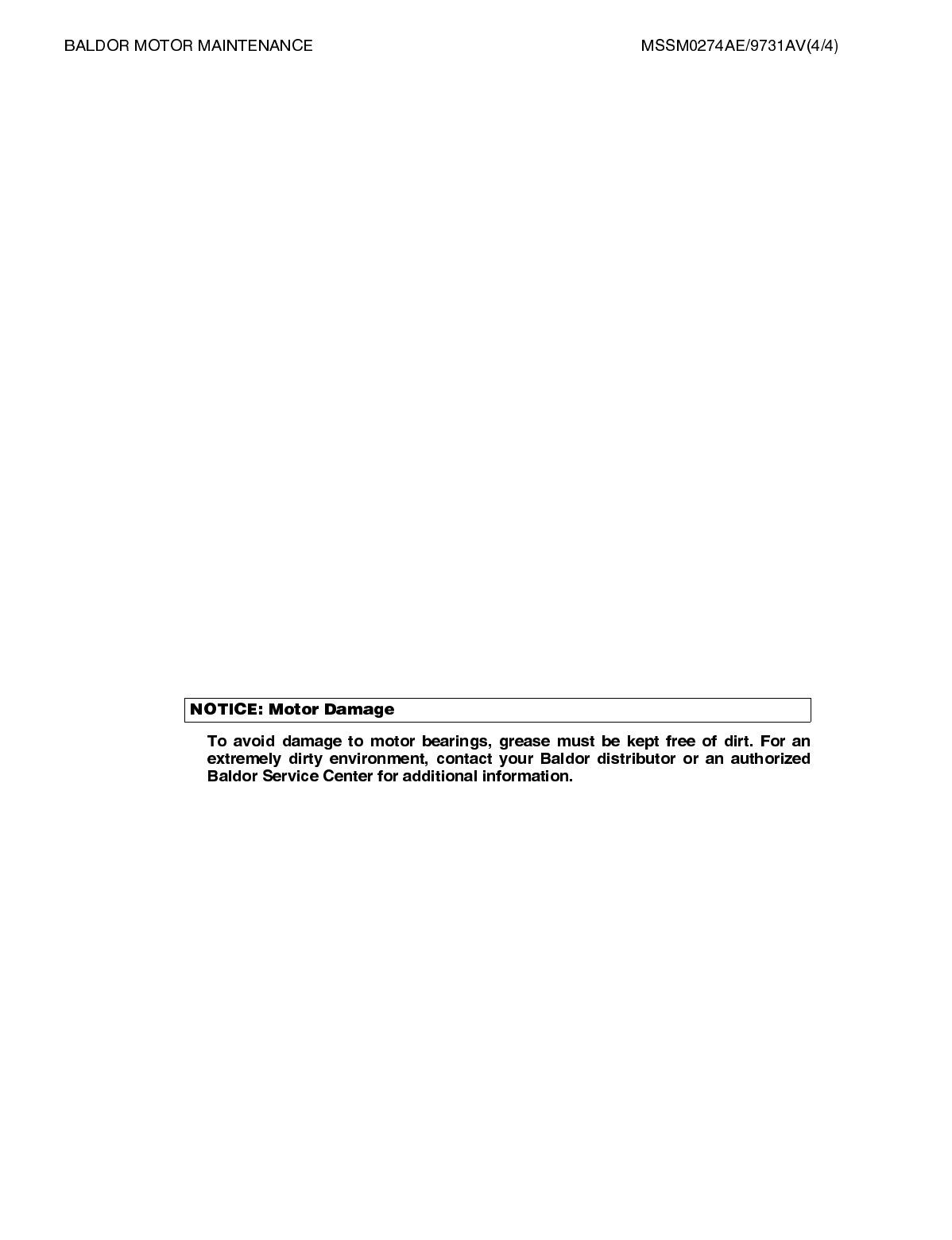
21<4?B=?D?B=19>D5>1>35
Most of the information in this document is taken from the Baldor Electric Company Instruction,
Operation, and Maintenance Manual, and provides a means of more accurately determining motor
lubrication requirements based on local conditions.
7U^UbQ\=QY^dU^Q^SU
Inspect, clean, and test motors at regular intervals— approximately every 500 operating hours
or every three months, whichever comes first. Lubricate motors at the intervals determined herein. Keep
accurate maintenance records.
!
☞
☞
!
☞
☞
3\UQ^
—Keep the exterior of the motor free of dirt, oil,
grease, water, etc. Keep ventilation openings clear. Oily
vapor, paper pulp, textile lint, etc., can accumulate and
block ventilation, causing overheating and early motor
failure.
DUcd
—Periodically, check the motor and winding
insulation integrity using a “megger.” Record the megger
readings and immediately investigate any significant drop
in insulation resistance. Check all electrical connectors to
be sure they are tight.
<eRbYSQdU
—Determine the proper lubrication interval
for your motor as explained in “How to Determine
Lubrication Interval” in this section, and lubricate
accordingly.

8_gd_4UdUb]Y^U<eRbYSQdY_^9^dUbfQ\
—The useful life of antifriction bearing
grease can be estimated, based on service conditions, frame type, and motor rpm. An example of
determining the correct lubrication interval is provided below.
Ex: A fan motor, operating at an ambient temperature of 109
o
F (43
o
C) in a moderately corrosive
atmosphere. The motor has a NEMA 286T/(IEC 180) frame and is rated at 1750 rpm.
Table 1 classifies the service condition as “severe.”
Table 2 specifies a 0.5 service condition multiplier value for “severe” service condition.
Table 3 specifies 9500 hours as the recommended lubrication interval for frame sizes 254 to 286
(see nameplate), given standard service conditions.
Multiply .5 (service condition multiplier value) by 9500 hours (recommended lubrication interval)
= 4750 hours (calculated lubrication interval).
Table 4 shows that the amount of grease to be added is 0.32 ounces (9.1 grams).
Table 1 — Determining the Service Condition
Severity of Service Maximum Ambient
Temperature
Atmospheric
Contamination
Type of Bearing
Standard 104
o
F (40
o
C) Clean, little corrosion Deep groove ball
bearing
Severe 122
o
F (50
o
C) Moderate dirt, corrosion Ball thrust, Roller
Extreme >122
o
F (>50
o
C) or
Class H Insulation
(Note 1)
Severe dirt, abrasive dust,
corrosion
All bearings
Low Temperature -22
o
F (-30
o
C)
(Note 2)
Note 1: Special high temperature grease is recommended.
Note 2: Special low temperature grease is recommended.
Table 2 — Service Condition Multiplier Value
Operating
Condition
Multiplier
Standard 1.0
Severe 0.5
Extreme 0.1

Table 3 — Recommended Lubrication Intervals at Standard Service Conditions
NEMA (IEC)
Frame Size
Rated Speed - RPM
3600 1800 1200 900
Up to 215 (132) 5500 Hrs. 12000 Hrs. 18000 Hrs. 22000 Hrs.
404 to 5000 (280 - 315) 2200 Hrs.(Note 3) 3500 Hrs. 7400 Hrs. 10500 Hrs.
Note 3: Bearings in 404 through 5000 frame, 2 pole motors are either 6313 or 6314 bearings and the
lubrication interval is shown in the table. If roller bearings are used, the bearings must be
lubricated more frequently. Divide the listed lubrication interval by two.
Table 4 — Lubrication Amounts per Frame
NEMA (IEC)
Frame Size
Bearing Description
These are the “Large” bearings (Shaft End) in each frame size (Note 4)
Largest
bearing
in size
category
OD
D mm
Width
B mm
Grease gun
strokes
(Note 5)
be added
ounces grams
Up to 215 (132) 6307 80 21 2.5 0.16 4.7
(160 - 180)
6311 120 29 5.0 0.32 9.1
(200 - 225)
6313 140 33 7.0 0.43 12.2
404 to 5000
(280 - 315)
NU322 240 50 18.0 1.11 31.5
Note 4: Smaller bearings in size category may require reduced amounts of grease.
Note 5: See “Correct Grease Gun Procedures” for information on estimating the output of hand-

<eRbYSQdY_^BUS_]]U^TQdY_^c
Di`U_V7bUQcU
—Use Shell Dolium R (factory installed) or Chevron SRI greases for standard
service conditions. The extreme and low temperature conditions are not normally encountered in the
laundry. However, for extreme conditions, use Darmex 707 and for low temperature conditions, use
Arrowshell 7. Contact Baldor for equivalents, if necessary.
3_bbUSd7bUQcU7e^@b_SUTebUc
Use hand-operated grease gun, not a pneumatic grease gun. Pump grease slowly, taking 10 to 12
seconds to complete each stroke.
Apply quantity of grease called for. Over-lubrication can be as damaging as under-lubrication.
Where quantities are stated in strokes, one stroke of the grease gun is assumed to provide .0624
fluid oz. (1.77 grams) (by volume) of grease. Therefore, one fluid ounce (28.3 grams) of grease
would be provided by 16 strokes of the grease gun. Determine the flow rate of your grease gun by
pumping one ounce into a calibrated container. If fewer than 16 strokes are required, all quantities
in strokes in the chart should be reduced accordingly. If more than 16 strokes are required, the
number of strokes should be increased. Before starting lubrication, make sure your grease gun
is working and that you get a full charge of grease with every stroke.
Do not over-lubricate motors. Over-lubrication of a motor can seriously damage it by forcing grease
into motor windings. Over-lubrication of the extract motor can force grease into the centrifugal
switch causing it to malfunction.
Do not allow grease to drip on the brake disk or clutch tire/drum during lubrication. This will reduce
the braking action considerably, and may permit the cylinder to creep while loading and unloading.
<eRbYSQdY_^@b_SUTebU
$
Clean grease fittings.
Remove grease outlet plug.
Add recommended amount of grease. Be sure grease to be added is compatible with the grease
already in motor. Consult your Baldor distributor or an authorized Baldor Service Center if grease
other than recommended is to be used. Stop when new grease appears at shaft hole in the endplate
or grease outlet plug.
Replace grease outlet plug.
